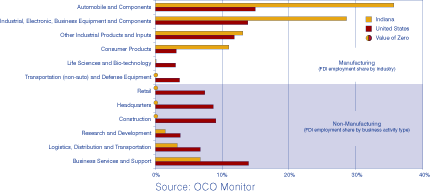Foreign Companies Invest in Indiana
Since 2005, firms in 16 countries have committed to bring investment to Indiana (see Figure 1). Despite the turmoil in the global credit markets, opinion leaders still expect foreign direct investment (FDI) to increase in 2008. According to the 2007 A.T. Kearney FDI Confidence Index, senior executives surveyed at the world’s largest companies were optimistic about the prospects for developing nations and increasingly targeting them for more corporate investment in the years ahead. The index provides a look at the future prospects for international investment flows. Companies participating in the survey account for more than $3.8 trillion in annual global revenue, according to the December 2007 A.T. Kearney press release.1
Figure 1: New Investments Announced in Indiana by Country of Origin, 2005 to 2007
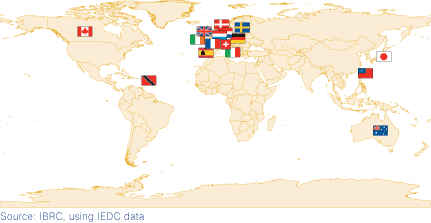
China and India are the most attractive destinations according to the survey, followed by the United States and the United Kingdom. Investors were evenly split over their plans for U.S. investment. Amid concerns about the country’s economic health, 52 percent of executives said they plan to increase their investments in the United States over the next three years, while 44 percent said they plan no change and 4 percent plan a decrease in their U.S. investments. The number one reason given for not investing more in the United States was the availability of other overseas investment options.
No single source of FDI data presents a complete picture. Using different concepts and data collection methods, the United Nations Conference on Trade and Development (UNCTAD), the Organisation for Economic Co-operation and Development (OECD), the U.S. Bureau of Economic Analysis, the Indiana Economic Development Corporation (IEDC), the Indiana Chamber of Commerce and OCO Consulting all collect and disseminate investment data. Each data series has strengths and weaknesses, so they are used collectively in order to present as complete a picture as possible.
In 2000, global FDI hit a record $1.4 trillion and rapidly declined until 2003. Since 2003, global FDI has gone from $558 billion to $1.31 trillion in 2006.2 Worldwide, the largest three recipients of FDI were the United States ($175.4 billion), the United Kingdom ($139.5 billion) and France ($81.1 billion).
The leading sources of FDI largely mirrored the leading destinations. The five leading sources of FDI were the United States, France, Spain, Switzerland and the United Kingdom. In terms of net FDI sources in 2006, the top five OECD source countries were Spain, the United States, Japan, Switzerland and Germany. The year 2006 was something of an anomaly for the United States because its cumulative total over the last 10 years indicates that the United States has been a net FDI destination.
According to UNCTAD, the rise in global FDI was partially fueled by rising corporate profits and was partially a result of the rising value of cross-border merger and acquisition due to higher stock prices. In addition to the growth of mergers and acquisitions (M&As), greenfield investment also increased, especially in developing and transition economies.3
The relative ranking of the world’s top non-financial transnational companies has been stable. In 2005, General Electric had the greatest value of foreign assets, the British company Vodafone Group had the highest percentage of assets in foreign investments (89.1 percent), and the Royal/Dutch Shell Group had the greatest percentage of company employees based in foreign operations (84.4 percent).
In 2005, employment of majority-owned U.S. affiliates was 5.1 million. While the number of jobs fell by nearly 46,000 (or about 1 percent), expenditures for property, plant and equipment by majority-owned U.S. affiliates increased $8.8 billion (or 7.8 percent) from 2004 to 2005.
Indiana Highlights
- Indiana ranked eighth nationally for the gross value of property, plant and equipment of majority-owned U.S. affiliates in 2005.
- In 2005, the ratio of the gross value of property, plant and equipment of majority-owned U.S. affiliates to Indiana’s gross state product was 0.145.4 Kentucky had a higher ratio, but the ratio for Indiana was well above the national average and all other Midwestern states.
- Majority-owned U.S. affiliates employed 139,900 people in 2005, or 4.4 percent of all private industry employment in Indiana (see Figure 2).
Figure 2: Majority-Owned U.S. Affiliate Employment, 2005
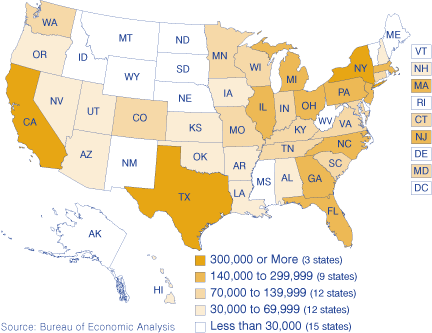
- In 2005, 92,000 Hoosier manufacturing jobs were attributed to majority-owned U.S. affiliates. Manufacturing jobs represent 66 percent of majority-owned U.S. affiliate employment, the third greatest share in the nation.
- Parent companies from Europe account for 65.4 percent of Indiana’s majority-owned U.S. affiliate employment, followed by Asia/Pacific countries (24.4 percent) and Canada (6.0 percent).
- The United Kingdom is the number one source of majority-owned U.S. affiliate employment (32,400 jobs). Japan contributes the second greatest number (32,000 jobs). Germany contributes 25,100 jobs.
New FDI Announcements in 2007 for Indiana
According to OCO Consulting,5 Indiana will gain nearly 5,000 jobs created by foreign investment in expansions of existing establishments and greenfield investments, comparable to the IEDC's announcements in 2007 of 5,397 new jobs due to upcoming FDI. Most of that new employment will be in the automobile manufacturing industry (about 36 percent). By way of contrast, the share of new jobs in automobile and auto-component manufacturing for the United States was 15 percent. Figures 3 and 4 show that Indiana will continue to gain manufacturing employment from FDI at a far greater proportion than the nation as a whole. The dispersion of jobs among industries and business activities was far greater for the United States than for Indiana.6
Figure 3: Share of New FDI Jobs by Business Activity in the United States and Indiana, Announcements in 2007
Figure 4: New FDI Created Jobs, 2007 Indiana Announcements
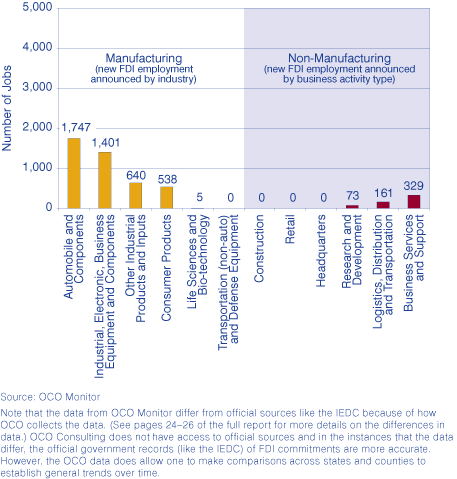
Figure 5 represents international projects completed by the IEDC from 2005 to 2007. The companies have committed to create a certain number of jobs and invest an indicated amount in order to be eligible to receive state incentives. From 2005 to 2007, Japan committed to the most number of jobs, followed by Germany, Taiwan, the United Kingdom and Canada. In terms of investment dollars into Indiana announced from 2005 to 2007, however, the United Kingdom led the world followed by Japan and Germany.
Figure 5: International Investment Commitments in Indiana, 2005 to 2007
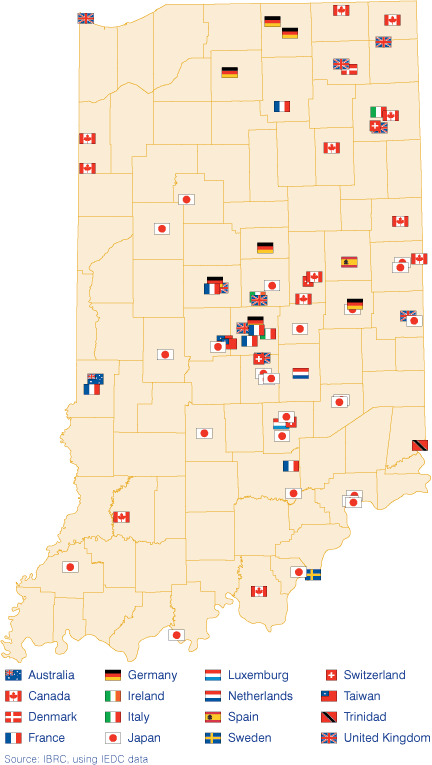
This report is one of an annual series for Indiana that focuses on foreign direct investment. The full report is available online at www.stats.indiana.edu/topic/exports.asp.
Notes
- The A.T. Kearney FDI Confidence Index measures executive opinion about foreign direct investment flows in the future. Available at www.atkearney.com/gbpc/foreign-direct-investment-confidence-index.
- Source: A.T. Kearney citing UNCTAD data.
- For the purposes of this report, transition economies refer to Southeast Europe and the Commonwealth of Independent States unless otherwise noted.
- The greater the ratio, the more significant FDI is to a state economy. The ratio can exceed unity.
- The OCO data report FDI and its expected employment as announced in the media and company press releases. In all but a few cases, the expected investment and job gains will occur in future years.
- Manufacturing, because it is so important for both FDI inflows and for Indiana’s economic output, is highlighted and broken down by industry. The remaining business activities were grouped into categories that are roughly defined by service industries. Presenting the data by industry would not provide any insight into the type of the firms commitment or the type of job that would be created.
Timothy Slaper, Director of Economic Analysis
Indiana Business Research Center, Kelley School of Business, Indiana University

